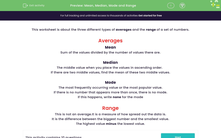What averages do you remember?

We might recall mean (the arithmetic average) or median (the middle number).
But there is also mode!
Mode is the most frequently occurring value or the most popular value.
Let's take the following data set of the number of siblings for example:
We can see 1 occurs three times whereas 0, 2 and 3 occur only once or twice.
So 1 is the mode.
Let's now have a look at the favourite fruits of 8 people:
Both apple and orange occur the most number of times (three times).
So in this case, we have two modes: apple and orange.
We call sets that have two modes bimodal.
We can also have no mode if there is no number that appears more than once.
So mode is another type of average. But what about range?
Range is the difference between the biggest number and the smallest value:
range = highest value - smallest value
If we look back at that set of numbers of siblings:
The range is not an average. It is a measure of spread, i.e. how spread out the data is.
For example, the numbers of siblings is spread out over the 'distance' of 3.
.jpg)
Let's have a go at some questions!




.jpg)





